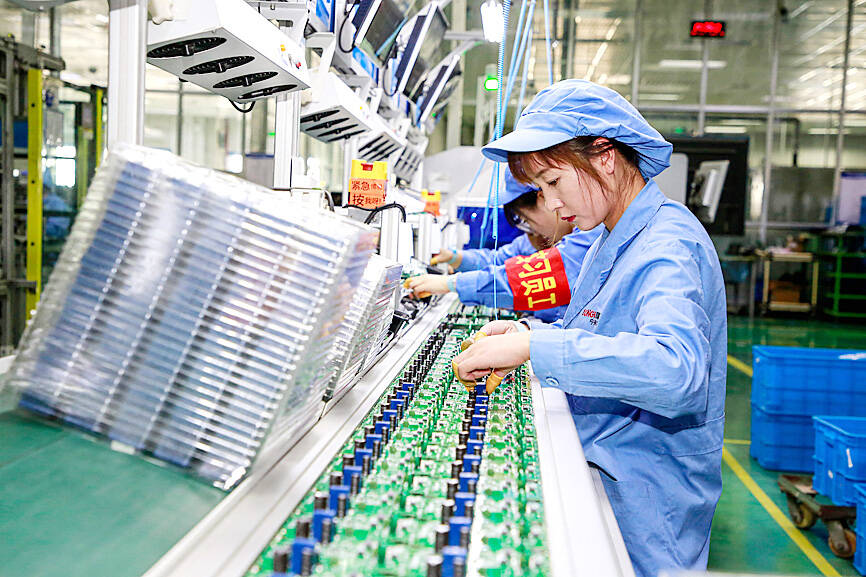New foreign investment into China slowed again last month, dealing a blow to policymakers’ efforts to attract more overseas capital to the world’s second-largest economy.
New actually utilized foreign investment into China was 102 billion yuan (US$14.1 billion) last month, according to calculations based on figures provided by the Chinese Ministry of Commerce yesterday. That was down 27 percent compared with the same month last year.
Efforts to convince overseas companies to return to China since the nation reopened after years of COVID-19 isolation are falling short. The continuing weakness highlights how foreign companies are putting less money into the nation due to geopolitical tensions and higher interest rates elsewhere.

Photo: AFP
The ministry in a statement accompanying the numbers said that fluctuations in investment data were normal, and the long-term outlook was strong with favorable conditions for investment.
Beijing’s efforts to woo back foreign capital has so far revolved around a series of action plans and warm language.
China in August last year announced a 24-point plan to address concerns, Chinese President Xi Jinping (習近平) promised “heart-warming” measures last year during a trip to the US, while this week the government unveiled another set of policies to further open up the Chinese market to foreign firms.
Officials on Wednesday said they had made progress on more than 60 percent of the 24-point plan at a news conference in Beijing, but foreign business groups have been more critical, saying they are still waiting to see how many of the pledges, which include better access to government contracts and relaxed regulations on transferring data overseas, are implemented.
There is also more incentive for multinationals to keep cash overseas, because advanced economies have been raising interest rates while Beijing has been cutting them to stimulate the economy.
New actually utilized foreign investment was 1.1 trillion yuan last year, 8 percent lower than the record in 2022.

TARIFF TRADE-OFF: Machinery exports to China dropped after Beijing ended its tariff reductions in June, while potential new tariffs fueled ‘front-loaded’ orders to the US The nation’s machinery exports to the US amounted to US$7.19 billion last year, surpassing the US$6.86 billion to China to become the largest export destination for the local machinery industry, the Taiwan Association of Machinery Industry (TAMI, 台灣機械公會) said in a report on Jan. 10. It came as some manufacturers brought forward or “front-loaded” US-bound shipments as required by customers ahead of potential tariffs imposed by the new US administration, the association said. During his campaign, US president-elect Donald Trump threatened tariffs of as high as 60 percent on Chinese goods and 10 percent to 20 percent on imports from other countries.

Taiwanese manufacturers have a chance to play a key role in the humanoid robot supply chain, Tongtai Machine and Tool Co (東台精機) chairman Yen Jui-hsiung (嚴瑞雄) said yesterday. That is because Taiwanese companies are capable of making key parts needed for humanoid robots to move, such as harmonic drives and planetary gearboxes, Yen said. This ability to produce these key elements could help Taiwanese manufacturers “become part of the US supply chain,” he added. Yen made the remarks a day after Nvidia Corp cofounder and chief executive officer Jensen Huang (黃仁勳) said his company and Taiwan Semiconductor Manufacturing Co (TSMC, 台積電) are jointly

United Microelectronics Corp (UMC, 聯電) expects its addressable market to grow by a low single-digit percentage this year, lower than the overall foundry industry’s 15 percent expansion and the global semiconductor industry’s 10 percent growth, the contract chipmaker said yesterday after reporting the worst profit in four-and-a-half years in the fourth quarter of last year. Growth would be fueled by demand for artificial intelligence (AI) servers, a moderate recovery in consumer electronics and an increase in semiconductor content, UMC said. “UMC’s goal is to outgrow our addressable market while maintaining our structural profitability,” UMC copresident Jason Wang (王石) told an online earnings

MARKET SHIFTS: Exports to the US soared more than 120 percent to almost one quarter, while ASEAN has steadily increased to 18.5 percent on rising tech sales The proportion of Taiwan’s exports directed to China, including Hong Kong, declined by more than 12 percentage points last year compared with its peak in 2020, the Ministry of Finance said on Thursday last week. The decrease reflects the ongoing restructuring of global supply chains, driven by escalating trade tensions between Beijing and Washington. Data compiled by the ministry showed China and Hong Kong accounted for 31.7 percent of Taiwan’s total outbound sales last year, a drop of 12.2 percentage points from a high of 43.9 percent in 2020. In addition to increasing trade conflicts between China and the US, the ministry said